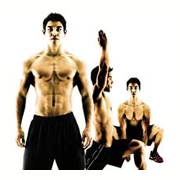How To Create Your Own Fitness Boot Camp
by Phil Lalli (Owner Sun Fitness Personal Training Studio)
 Just about every fitness centre and gym seems to offer a version of the trendy boot camp workout these days. Some go with a pseudo-militaristic theme, complete with camouflage gear. Others refer to standard circuit classes as boot camps.
Just about every fitness centre and gym seems to offer a version of the trendy boot camp workout these days. Some go with a pseudo-militaristic theme, complete with camouflage gear. Others refer to standard circuit classes as boot camps.
Deciding what type of boot camp workout you want to teach determines where you'll hold it, what equipment you'll need, what exercises you'll introduce to clients and, most importantly, who your target clientele will be.
Choosing a target clientele
If your strength as a trainer lies in postpartum fitness, consider designing a boot camp for new mums. Or perhaps you have athletic experience and are good with team sports. Why not target participants who enjoy higher-intensity, athletic training? Stick with your strengths, and your creativity will follow.
Liability issues
Before starting your boot camp classes, check with your professional liability insurance carrier to make sure that you are covered to teach in a group or outdoor setting and also that the exercises you present are covered under your policy. Know what your class is capable of and monitor class participants closely to minimize the chance of injury.
Boot Camp programming
Design a program that gradually increases in intensity over the length of the course. For example, you would not teach plyometrics on day one, but you should not have to instruct proper crunch form on day 15 either.
Class design
Begin each class as if you were teaching an aerobics class: do light cardiovascular movements, such as running, skipping rope, squat thrusts, etc. Follow the cardiovascular exercise with graduated stretches of the body parts that you plan to train more intensely during that session.
For the rest of the class, I like to alternate intermediate cardio with callisthenics and core conditioning. For instance, my clients do a ¼-mile run in their best effort without completely exhausting them followed by lunges and standing hip abductions before doing martial arts-style abdominal work in a standing position (e.g., hip/torso flexion).
They rest for upwards of 90 seconds and then transition back into 2-5 additional minutes of cardio, followed by drills like push-ups, medicine ball tosses and seated abdominal chops. Whatever exercises you decide to teach, keep your programming simple and fun!
Phil A. Lalli is the owner/operator of Sun Fitness Personal Training Studio in Tampa, Florida. Visit: www.howtoprofitwithbootcamps.com tofind out more!
|
|
|









 Just about every fitness centre and gym seems to offer a version of the trendy boot camp workout these days. Some go with a pseudo-militaristic theme, complete with camouflage gear. Others refer to standard circuit classes as boot camps.
Just about every fitness centre and gym seems to offer a version of the trendy boot camp workout these days. Some go with a pseudo-militaristic theme, complete with camouflage gear. Others refer to standard circuit classes as boot camps.